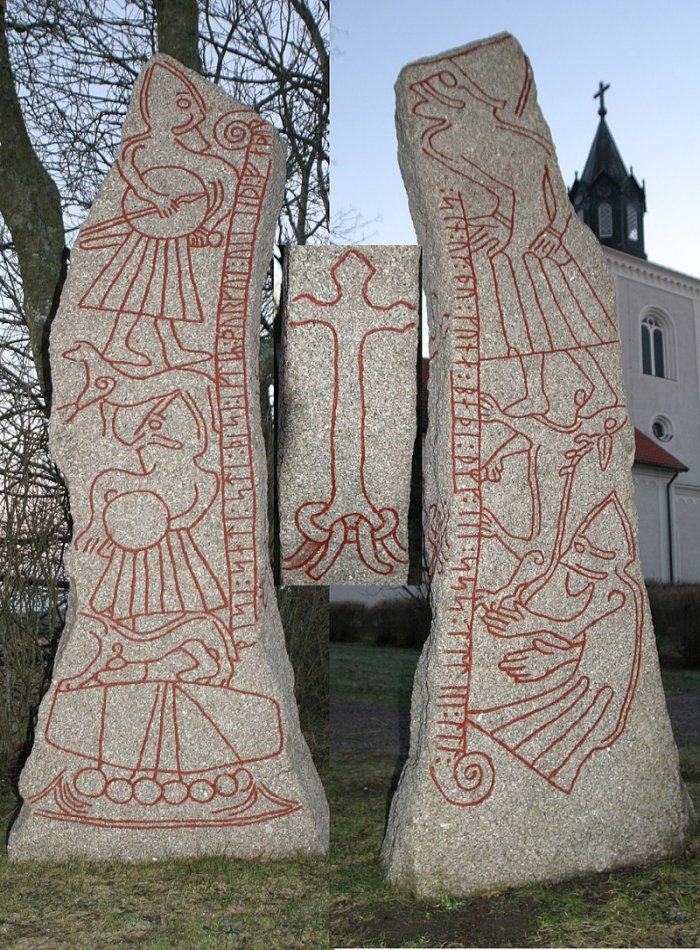A. Sutherland – AncientPages.com – The Ledberg Stone (Ledbergsstenen) is considered one of Sweden’s most beautiful Runestones. This landmark is also one of the country’s more familiar runestones due to its beautiful and imaginative adornment. Some parts of its motif are taken from the famous religious myth of Ragnarök, the final battle in Norse mythology, in which several gods meet their death.

The Ledberg Stone (Ledbergsstenen) is considered one of Sweden’s most beautiful Runestones. Image credit: Olof Ekström 2004-12-31. Transferred by Maksim (to commons) – CC BY-SA 3.0
Among other depictions on the stone, there is Fenrir (the Wolf) – the oldest of three terrible children of Loki, according to the literary works Poetic Edda (the Icelandic medieval manuscript known as the Codex Regius) and Snorri Sturluson’s Prose Edda, and Heimskringla.
The Ledberg Stone – commonly dated to the 11th century – stands at Ledberg church, close to Ledberg Hill, Östergötland’s largest burial mound.
The stone’s unique ornamentation also depicts god Odin devoured by Fenrir when the whole world falls.
It is difficult to say if it is the Ragnarok drama that the ancient artists wanted to illustrate on this remarkable runestone. Still, there are certain similarities between the carved images and the events described in the legend of Ragnarok.
The runestone was built into the wall in Ledberg’s old church for a couple of hundred years. It is not exactly known where the stone was initially erected.
However, the church was demolished in the 1850s, and the stone had to be removed.
On the front side of the stone, there are two helmet-adorned Viking warriors. One is depicted with a sword, spear, and shield, and the other only with a shield. On the front are also two animals and a ship.
Also, on the opposite side is the depiction of two warriors, but without weapons. Between these warriors, there is an animal. The figures have been interpreted as a representation of Ragnarok. According to this interpretation, The warrior is the god Odin who – on the stone’s front side, is getting ready for battle, and then he encounters the ship Naglfar, which, according to legend, is manned by all the creatures of evil, and carries demonic forces to Ragnarok.
This great Norse story continues – through images – on the back of the Ledberg Stone, showing Odin attacked by the Fenris beast. Odin is defeated, and the great Battle is finally over.
As we find in “The Symbolism of Plants: The Gods of the Germanic Peoples,” Volume 45, Volume 45, by Harry Eilenstein, on the Ledberg Stone is written:
“Square hole… his father, the two of them, Bise and Gunna (raised the stone).”
“On this runestone, which was built about 1050 for the name “Thorgautr,” you can find a very special inscription (carved in the Younger futhark) with a magic formula.
The following three words are:
Thistle mistletoe kiste
That gives the sentence or, more precisely, the picture: “A thistle and a mistletoe in a box.”
Why Were These Runes Important?
These runes would protect the stone from impact. This magic formula contains three magic words:
In ancient Norse beliefs, people believed that these words had magical properties. The same magic spell was discovered on many stones in the Nordic countries.
The Ledberg Stone is carved on three sides. Its third side is covered with the carving of a cross. It is dated to the 11th century.
Written by – A. Sutherland – AncientPages.com Senior Staff Writer
Copyright © AncientPages.com All rights reserved. This material may not be published, broadcast, rewritten or redistributed in whole or part without the express written permission of AncientPages.com





